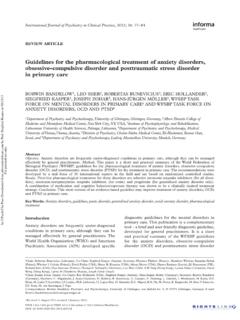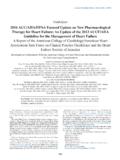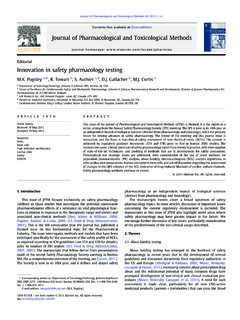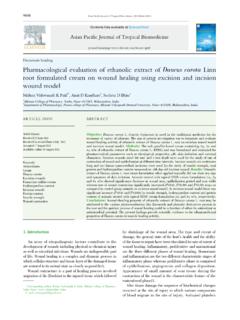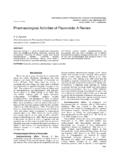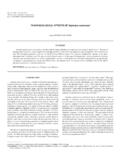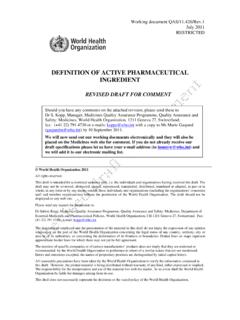Transcription of Guidelines for the Psychosocially Assisted Pharmacological ...
1 Guidelines for the Psychosocially Assisted Pharmacological Treatment of Opioid DependenceGuidelines for the PsychosociallyAssisted Pharmacological Treatmentof Opioid DependenceFor more information, please contact:Management of Substance Abuse TeamDepartment of Mental Health and Substance AbuseWorld Health Organization20 Avenue Appia, CH-1211 Geneva 27, SwitzerlandTel: +41 22 791 2352; Fax: +41 22 791 4851 Email: 978 92 4 154754 3 The Guidelines for the Psychosocially Assisted Pharmacological Treatment of Opioid Dependence review the use of medicines such as methadone, buprenorphine, naltrexone and clonidine in combination with psychosocial support in the treatment of people dependent on heroin or other opioids. Based on systematic reviews of the literature and using the GRADE approach to determining evidence quality, the Guidelines contain specific recommendations on the range of issues faced in organizing treatment systems, managing treatment programmes and in treating people dependent on opioids.
2 Developed in collaboration with internationally acclaimed experts from the different regions of the globe, the Guidelines for the Psychosocially Assisted Pharmacological Treatment of Opioid Dependence should be of interest to policy makers, programme managers, and clinicians everywhere who seek to alleviate the burden of opioid for the Psychosocially Assisted Pharmacological Treatment of Opioid Dependence World Health Organization 2009 All rights reserved. Publications of the World Health Organization can be obtained from WHO Press, World Health Organization, 20 Avenue Appia, 1211 Geneva 27, Switzerland (tel.: +41 22 791 3264; fax: +41 22 791 4857; e-mail: Requests for permission to reproduce or translate WHO publications whether for sale or for noncommercial distribution should be addressed to WHO Press, at the above address (fax: +41 22 791 4806; e-mail: The designations employed and the presentation of the material in this publication do not imply the expression of any opinion whatsoever on the part of the World Health Organization concerning the legal status of any country, territory, city or area or of its authorities, or concerning the delimitation of its frontiers or boundaries.))
3 Dotted lines on maps represent approximate border lines for which there may not yet be full mention of specific companies or of certain manufacturers products does not imply that they are endorsed or recommended by the World Health Organization in preference to others of a similar nature that are not mentioned. Errors and omissions excepted, the names of proprietary products are distinguished by initial capital reasonable precautions have been taken by the World Health Organization to verify the information contained in this publication. However, the published material is being distributed without warranty of any kind, either expressed or implied. The responsibility for the interpretation and use of the material lies with the reader. In no event shall the World Health Organization be liable for damages arising from its design by Zando EsculturaPrinted in WHO Library Cataloguing-in-Publication DataGuidelines for the Psychosocially Assisted Pharmacological treatment of opioid disorders - drug therapy.
4 Disorders - psychology. abuse - prevention and control. Health Organization. Dept. of Mental Health and Substance 978 92 4 154754 3 (NLM classification: WM 284)iContentsAcknowledgements ivAbbreviations and acronyms ixExecutive summary xSummary of recommendations xiv1 Scope and purpose 12 Method of formulating recommendations Conventions for reporting clinical trial data 43 Background Opioid dependence Neurobiological aspects of opioid dependence Epidemiology of illicit opioid use and dependence Harms associated with opioid use Economic consequences of opioid use Natural history of opioid dependence Opioid dependence as a medical condition Treatment of opioid dependence Management of opioid withdrawal Agonist maintenance treatment Psychosocial assistance 74 Guidelines for health systems at national and subnational levels International regulations Opioid dependence as a health-care issue National treatment policy Ethical issues Compulsory and coerced treatment Central registration of patients Funding
5 Coverage Primary care Prisons What treatments should be available? Supervision of dosing for methadone and buprenorphine maintenance 135 Programme level Guidelines for programme managers and clinical leaders Clinical governance Ethical principles and consent Staff and training Medical staff Pharmacy staff Psychosocial support staff Clinical records 16 ContentsiiGuidelines for the Psychosocially Assisted Pharmacological Treatment of Opioid Medication safety Treatment provision Clinical Guidelines Treatment policies Involuntary discharge and other forms of limit setting Individual treatment plans Range of services to be provided Treatment of comorbid conditions Psychosocial and psychiatric support TB, hepatitis and HIV Hepatitis B vaccination Treatment evaluation 216 Patient level Guidelines for clinicians Diagnosis and assessment of opioid dependence urine drug screening Testing for infectious diseases Identifying the patient Completing the assessment Diagnostic criteria Making the diagnosis Choice of treatment approach Opioid agonist maintenance treatment Indications for opioid agonist maintenance treatment Choice of agonist maintenance treatment Initial doses of opioid agonist maintenance treatment Fixed or flexible dosing in agonist maintenance treatment Maintenance doses of methadone Maintenance doses of buprenorphine Supervision of dosing in opioid agonist maintenance treatment Optimal duration of opioid agonist treatment Use of psychosocial interventions in maintenance treatment Management of opioid withdrawal Signs.
6 Severity and treatment principles Assessment of opioid withdrawal Choice of treatments for assisting withdrawal from opioids Accelerated withdrawal management techniques Treatment setting for opioid withdrawal Psychosocial assistance in addition to Pharmacological assistance for opioid withdrawal Opioid antagonist (naltrexone) treatment Indications for opioid antagonist therapy Indications for naltrexone therapy Psychosocial interventions Psychological interventions Social interventions Provision of psychosocial support Treatment of overdose Special considerations for specific groups and settings Patients with HIV/AIDS, hepatitis and TB Adolescents Women Pregnancy and breastfeeding Opium users Driving and operating machinery Psychiatric comorbidity with opioid dependence Polysubstance dependence Management of pain in patients with opioid dependence Acute pain Chronic pain 54 Annex 1 Evidence profiles 55 Annex 2 Dispensing.
7 Dosing and prescriptions 70 Annex 3 ICD-10 codes for conditions covered in these Guidelines 71 Annex 4 Pharmacology of medicines available for the treatment of opioid dependence 72 Annex 5 Drug interactions involving methadone and buprenorphine 74 Annex 6 Alternatives for the treatment of opioid dependence not included in the current Guidelines 77 Annex 7 Methadone and buprenorphine and international drug control conventions 78 Annex 8 Priorities for research 82 Annex 9 Background papers prepared for technical expert meetings to inform guideline development 84 Annex 10 Opioid withdrawal scales 85 Annex 11 Summary of characteristics of selected psychoactive substances 89 Annex 12 Prescribing Guidelines 90 Annex 13 Glossary 93 References 96ivGuidelines for the Psychosocially Assisted Pharmacological Treatment of Opioid DependenceThese Guidelines were produced by the World Health Organization (WHO), Department of Mental Health and Substance Abuse, in collaboration with the United Nations Office on Drugs and Crime (UNODC) a Guidelines Development Group of technical experts, and in consultation with the International Narcotics Control Board (INCB) secretariat and other WHO departments.
8 WHO also wishes to acknowledge the financial contribution of UNODC and the Joint United Nations Programme on HIV/AIDS (UNAIDS) to this DeVelOPMenT GROUPM arina DavoliCoordinating editorCochrane Review Group on Drugs and AlcoholDepartment of epidemiologyOsservatorio epidemiologico Regione lazioRomaItalyMichael FarrellReader/Consultant Psychiatristnational Addiction CentreInstitute of Psychiatry and the Maudsley HospitallondonUnited KingdomDavid FiellinAssociate Professor of MedicineYale University School of MedicineUnited States of America Li JianhuaDeputy DirectorYunnan Institute for Drug AbuseChinaRatna MardiatiPsychiatristDirectorate General for Medical CareJakartaIndonesiaRichard MattickDirectornational Drug and Alcohol Research CentreUniversity of new South WalesSydneyAustraliaElena Medina-MoraDirectorepidemiology and Psychosocial Researchnational Institute of PsychiatryMexicoFred OwitiConsultant PsychiatristArrow Medical CentrenairobiKenyaAfarin Rahimi-MovagharIranian national Center for Addiction
9 StudiesTehran University of Medical SciencesTehranIranRajat RayChiefnational Drug Dependence Treatment CentreAll India Institute of Medical Sciencesnew DelhiIndiaAnthony J Smithemeritus ProfessorClinical Pharmacologynewcastle Mater HospitalAustraliaEmilis SubataDirectorVilnius Center for Addictive DisorderslithuaniaAmbros UchtenhagenPresidentResearch Institute for Public Health and AddictionZurichSwitzerlandvOBSeRVeRSCoun cil of EuropeGabrielle Welle-StrandSenior Advisernorwegian Directorate for Health and Social AffairsnorwayInternational Narcotics Control Board SecretariatPavel PachtaChief, narcotics Control and estimates SectionViennaAustriaCarmen Selva-BartolomeChief, Psychotropics Control Section (until September 2007)Vienna AustriaMargarethe ehrenfeldnerChief, Psychotropics Control Section (as of 1 October 2007)Vienna AustriaDepartment of Mental Health and Substance AbuseVladimir PoznyakCo-ordinatornicolas ClarkMedical OfficerHannu AlhoTemporary Advisor (seconded from the national Public Health Institute of Finland [KTl])
10 Department of HIVA nnette VersterTechnical OfficerDepartment of Health Systems FinancingDan ChisholmeconomistDepartment of Medicines Policy and StandardsSue HillMedical Officernicola MagriniMedical OfficerAcknowledgementsJuana Tomas-RosselloDrug Abuse Treatment Adviser, Global Challenges SectionVienna AustriaWORlD HeAlTH ORGAnIZATIOn SeCReTARIATUnITeD nATIOnS OFFICe On DRUGS AnD CRIMe SeCReTARIATviGuidelines for the Psychosocially Assisted Pharmacological Treatment of Opioid DependenceOther contributorslaura Amato, Department of epidemiology, Azienda Sanitaria locale "e", Rome, ItalyMike Ashton, Drug and Alcohol Findings, United KingdomAnna Maria Bargagli, Department of epidemiology, Azienda Sanitaria locale "e", Rome, ItalyJames Bell, national Addiction Centre, london, United KingdomAdrian Carter, Queensland Brain Institute, University of Queensland, AustraliaZhang Cunmin, Yunnan Institute for Drug Abuse, Kunming, Yunnan, ChinaChris Doran, national Drug & Alcohol Research Centre, University of new South Wales, AustraliaColin Drummond, St George s, University of london, United KingdomRalph edwards, Director, Uppsala Monitoring Centre, SwedenGabriele Fischer, Medical University of Vienna, AustriaAndy Gray, University of KwaZulu-natal, Durban, South AfricaWayne Hall, School of Population Health, University of Queensland, AustraliaS Kattimani, national Drug Dependence Treatment Centre, All India Institute of Medical Sciences, new Delhi, Indianina Kopf, Department of Psychiatry, Medical University of Vienna, AustriaT ladjevic, Research Institute for Public Health and Addiction.










